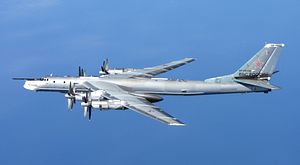The Japan Air Self-Defense Force (JASDF) scrambled fighter jets to intercept two Russian Air Force nuclear-capable Tupolev Tu-95MS strategic bombers on February 20, the Japanese Ministry of Defense (MoD) announced in a statement.
The two bombers, escorted by Sukhoi Su-35S (Flanker-E+) multirole fighter jets, flew down the entirety of Japan’s East coast hurtling close to U.S. and Japanese military bases including Misawa Air Base, Yokosuka Naval Base and Atsugi Air Base. The Russian bombers were shadowed by F-2, F-4, and F-15 JASDF fighter jets. According to the Japanese MoD, Japanese airspace was not trespassed.
“The flight lasted more than 15 hours. During the flight, the crew members, namely the commander, commander assistant, flight navigators, onboard signal operator and flight engineer, complied with their commitments strictly,” Tu-95MS aircraft commander Major Ilya Smirnov told the Krasnaya Zvezda newspaper last week. “Common success and the fulfillment of a common mission depend on how well each crew member performs their duties,” he added.
“Upgraded Tu-95MS planes operational with Russia’s Long-Range Aviation have advanced navigation systems and short- and long-range navigation electronic devices making navigation support as effective as possible. We face no difficulties despite the geographical location of our flights,” Tu-95MS flight navigator Captain Sergei Ryzhov said, according to the newspaper report.
The Tu-95MS aircraft is an updated variant of the older Tu-95, a Soviet-era four-engine, long-range, turboprop, strategic bomber that can carry stand-off nuclear-capable cruise missiles. Russia is currently upgrading its Tu-95MS fleet and is expecting to operate up to 20 retrofitted aircraft in the near future. “The upgraded aircraft, along with the Tu-22M3 long-range bomber, will form the core of a new Russian heavy bomber division in Russia’s Far East to conducts patrol Pacific Ocean inside the Japan-Hawaii-Guam triangle,” I explained in 2017.
Two Tu-95MS strategic bombers last flew along the perimeter of Japanese airspace in October 2017. In April 2017, two Tu-95MS bombers and one Ilyushin Il-20 maritime reconnaissance and anti-submarine warfare aircraft also skirted Japanese airspace during a long-range patrol. Additionally, in January 2017, JASDF fighter jets intercepted three Russian Tu-95 strategic bombers circumnavigating the major islands — Hokkaido, Honshu, Shikoku, and Kyushu — of the Japanese archipelago.
Russian nuclear-capable Tupolev Tu-95MS strategic bombers, accompanied by Su-35S fighter jets and an A-50 airborne early warning aircraft, also conducted a patrol in close vicinity to the Korean Peninsula prompting the Republic of Korea Air Force (ROKAF) and JSDF to scramble fighter jets in August 2017. During their flight, the Russian aircraft briefly entered South Korea’s air defense identification zone (KADIZ) as Russia does not recognize KADIZs of neighboring countries.
Japan is facing a shortage of fighter aircraft as China and Russia have stepped up their aerial patrol activities in the region. The JASDF is in the process of inducting F-35A Lightning II fifth-generation stealth fighter jets, the conventional take-off and landing (CTOL) variant of the aircraft.
































